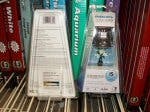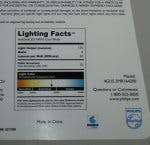Good news, you would think. Except that Philips had not received their labels from the Lighting Facts organization, but had instead gone ahead and made the labels themselves.
Companies normally register for the program, take the Quality Advocates pledge, then submit products along with performance data. When the data is verified, a Lighting Facts label is issued (see "How do I create my labels?" below).
Lighting Facts labels are clearly important and highly useful, so hopefully the lessons learned from this episode will strengthen the labeling program...and also prevent other companies from repeating Philips' mistake.
Kevin Dowling, VP of Innovation with Philips Color Kinetics, provided an official explanation to LEDs Magazine on behalf of Philips. "The labeling issue was a procedural error on our part," he said.
"While other Philips business units registered with Lighting Facts and signed the [Quality Advocates] pledge, the retail lamps group mistakenly assumed that this was sufficient to cover other parts of the organization. As soon as they were notified of this issue last week, they completed both very quickly. Additionally, they are supplying the necessary test reports to comply with the DOE requirements.
"While embarrassing, we responded quickly, correctly, and completely," continued Dowling. "We also put measures in place to ensure this will not happen again. This includes internal procedures and designated contact points for the DOE and DOE contractors handling the Lighting Facts program."
"It may surprise you, but we appreciate the DOE's action," continued Dowling. "It shows the program works and that enforcement exists and works. The point of Lighting Facts is to insure valid product claims and quality products. It works."
However, one worrying aspect of the Philips situation is that the DOE was unaware of the Philips lamps until they were alerted by another manufacturer of LED-based products.
As Dowling says, this is embarrassing for Philips, and unfortunately also for the Lighting Facts program. The Home Depot, a Lighting Facts partner, was also unimpressed.
Recently, but before the Philips incident, Jim Brodrick (who runs the DOE Solid State Lighting program) wrote in a Postings email that DOE was "in the process of revising the Lighting Facts label to make it harder to counterfeit. Unfortunately, this was made necessary because we have had a couple of instances in which manufacturers decided it might be a good idea to fabricate a facsimile to mirror the Lighting Facts label. Luckily, we were able to put a stop to such actions before they reached the market. Let me assure you all that there will be little tolerance for manufacturers that attempt to cheat the system."
About the Lighting Facts label
Taken from the Lighting Facts website.
"The Lighting Facts label is registered to the U.S. Department of Energy. Only Lighting Facts labels that are provided by and in accordance with the SSL Quality Advocates program and Lighting Facts Product registration process are allowed. Any manufacturer or agent who reproduces, alters or recreates the Lighting Facts label outside of the program requirements will be subject to penalties of trademark infringement and will not be allowed to participate in the SSL Quality Advocates program."
How do I create my labels? Register on LightingFacts.com to establish an account. We’ll send a confirmation email, after which you may complete the online pledge form. Any time after you have completed the pledge, you may log on and submit products. Once you've successfully submitted products, and they have been approved by passing through our verification process, you will be able to click the label icon next any approved products. Once clicked, a print-quality version of the label complete with your products unique characteristics will automatically be downloaded directly to your computer.
What information do I need to collect? For each product, you will need the measurements from your IESNA LM-79-2008 test report. Product testing must be done in accordance with the industry standardized test procedure.







